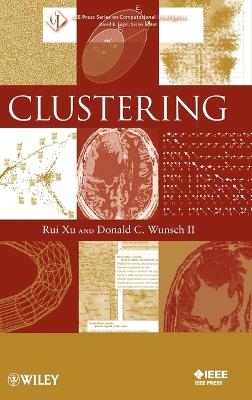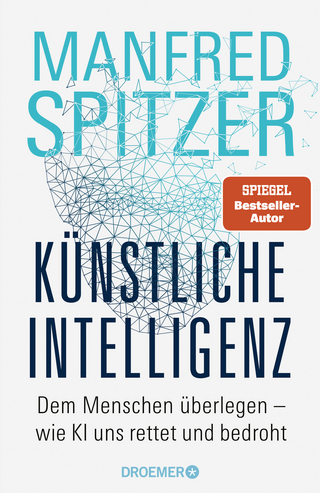
Clustering
Wiley-IEEE Press (Verlag)
978-0-470-27680-8 (ISBN)
This is the first book to take a truly comprehensive look at clustering. It begins with an introduction to cluster analysis and goes on to explore: proximity measures; hierarchical clustering; partition clustering; neural network-based clustering; kernel-based clustering; sequential data clustering; large-scale data clustering; data visualization and high-dimensional data clustering; and cluster validation. The authors assume no previous background in clustering and their generous inclusion of examples and references help make the subject matter comprehensible for readers of varying levels and backgrounds.
Rui Xu, PhD, is a Research Associate in the Department of Electrical and Computer Engineering at Missouri University of Science and Technology. His research interests include computational intelligence, machine learning, data mining, neural networks, pattern classification, clustering, and bioinformatics. Dr. Xu is a member of the IEEE, the IEEE Computational Intelligence Society (CIS), and Sigma Xi. Donald C. Wunsch II, PhD, is the M.K. Finley Missouri Distinguished Professor at Missouri University of Science and Technology. His key contributions are in adaptive resonance and reinforcement learning hardware and applications, neurofuzzy regression, improved Traveling Salesman Problem heuristics, clustering, and bioinformatics. He is an IEEE Fellow, the 2005 International Neural Networks Society (INNS) President, and Senior Fellow of the INNS.
PREFACE. 1. CLUSTER ANALYSIS.
1.1. Classifi cation and Clustering.
1.2. Defi nition of Clusters.
1.3. Clustering Applications.
1.4. Literature of Clustering Algorithms.
1.5. Outline of the Book.
2. PROXIMITY MEASURES.
2.1. Introduction.
2.2. Feature Types and Measurement Levels.
2.3. Defi nition of Proximity Measures.
2.4. Proximity Measures for Continuous Variables.
2.5. Proximity Measures for Discrete Variables.
2.6. Proximity Measures for Mixed Variables.
2.7. Summary.
3. HIERARCHICAL CLUSTERING.
3.1. Introduction.
3.2. Agglomerative Hierarchical Clustering.
3.3. Divisive Hierarchical Clustering.
3.4. Recent Advances.
3.5. Applications.
3.6. Summary.
4. PARTITIONAL CLUSTERING.
4.1. Introduction.
4.2. Clustering Criteria.
4.3. K-Means Algorithm.
4.4. Mixture Density-Based Clustering.
4.5. Graph Theory-Based Clustering.
4.6. Fuzzy Clustering.
4.7. Search Techniques-Based Clustering Algorithms.
4.8. Applications.
4.9. Summary.
5. NEURAL NETWORK–BASED CLUSTERING.
5.1. Introduction.
5.2. Hard Competitive Learning Clustering.
5.3. Soft Competitive Learning Clustering.
5.4. Applications.
5.5. Summary.
6. KERNEL-BASED CLUSTERING.
6.1. Introduction.
6.2. Kernel Principal Component Analysis.
6.3. Squared-Error-Based Clustering with Kernel Functions.
6.4. Support Vector Clustering.
6.5. Applications.
6.6. Summary.
7. SEQUENTIAL DATA CLUSTERING.
7.1. Introduction.
7.2. Sequence Similarity.
7.3. Indirect Sequence Clustering.
7.4. Model-Based Sequence Clustering.
7.5. Applications—Genomic and Biological Sequence.
7.6. Summary.
8. LARGE-SCALE DATA CLUSTERING.
8.1. Introduction.
8.2. Random Sampling Methods.
8.3. Condensation-Based Methods.
8.4. Density-Based Methods.
8.5. Grid-Based Methods.
8.6. Divide and Conquer.
8.7. Incremental Clustering.
8.8. Applications.
8.9. Summary.
9. DATA VISUALIZATION AND HIGH-DIMENSIONAL DATA CLUSTERING.
9.1. Introduction.
9.2. Linear Projection Algorithms.
9.3. Nonlinear Projection Algorithms.
9.4. Projected and Subspace Clustering.
9.5. Applications.
9.6. Summary.
10. CLUSTER VALIDITY.
10.1. Introduction.
10.2. External Criteria.
10.3. Internal Criteria.
10.4. Relative Criteria.
10.5. Summary.
11. CONCLUDING REMARKS.
PROBLEMS.
REFERENCES.
AUTHOR INDEX.
SUBJECT INDEX.
| Erscheint lt. Verlag | 7.11.2008 |
|---|---|
| Reihe/Serie | IEEE Press Series on Computational Intelligence |
| Zusatzinfo | Charts: 85 B&W, 0 Color; Photos: 15 B&W, 0 Color; Tables: 10 B&W, 0 Color; Graphs: 55 B&W, 0 Color |
| Sprache | englisch |
| Maße | 165 x 243 mm |
| Gewicht | 708 g |
| Themenwelt | Informatik ► Theorie / Studium ► Künstliche Intelligenz / Robotik |
| Mathematik / Informatik ► Mathematik | |
| Technik ► Elektrotechnik / Energietechnik | |
| ISBN-10 | 0-470-27680-0 / 0470276800 |
| ISBN-13 | 978-0-470-27680-8 / 9780470276808 |
| Zustand | Neuware |
| Haben Sie eine Frage zum Produkt? |
aus dem Bereich


